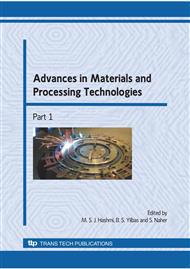p.67
p.77
p.88
p.94
p.101
p.106
p.113
p.125
p.133
Friction and Bitten Condition in Cold Ring Rolling
Abstract:
Analytic calculation and Finite Element Method simulation are used to research the relationship between friction and bitten condition in cold ring rolling. It is found: if the ring can’t be bitten in groove, rolling process will be stopped. The rolling force will increase rapidly, which will cause the breakage of rolls and equipment. When the feed velocity and other technical parameters are kept unchanged, the bitten condition will be disappeared with the process of ring rolling even if the ring can be bitten at the beginning stage.
Info:
Periodical:
Pages:
101-105
Citation:
Online since:
December 2009
Keywords:
Price:
Сopyright:
© 2010 Trans Tech Publications Ltd. All Rights Reserved
Share:
Citation:


